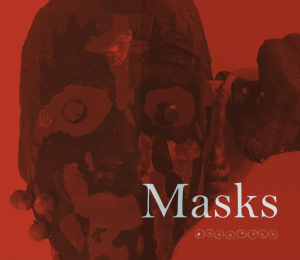MASK MAKING
© E. Hitchcock Scott, PhD, 1995-2003.
Since ancient times, before language, man made image. Marks were made on stones and the walls of caves by the earliest humans, we hypothesize, to establish absentia communication and personal or community identity. The commonly recognized prehistoric cave hand print suggests, “I am,” or “I exist”.
Cave drawings of animals were used to prepare for the hunt, to bolster courage, and to call on the aid of spirits for success and protection. In the age of prelanguage, masks were used in much the same fashion as cave drawings. What stands out about masks, that is a bit different from the phenomenon of cave drawings, is the representation of the faces of god(s), with the specific agenda to embody divine spirit in flesh. The tribal leader would wear the mask of a deity’s face, and while in a trance state, imagine becoming the diety in order to better perform sacred healing rituals.
In the contemporary therapeutic setting, mask making is an interdisciplinary activity that may incorporate existential, ego-state, phenomenological and/or Jungian psychology, social commentary/activism, multiculturalism, biology, health and sickness, and spirituality.
Masks have been created and used by human beings for at least 30,000 years. “The origins of the word mask are unclear, but it probably comes from the Arabic maskhara (mashara), which meant “to falsify” or “transform” into animal, monster, or freak.” (Numley and McCarty, 1999, p. 15)
In a video by Gillian Wearing entitled, “Trauma,” she has her subject wear the mask of a child’s face and a, ”blatantly synthetic wig,” while talking about her childhood sexual abuse.
The author Roberta Smith responds to the video in these words, “The mask alters the revelation in a fascinating way, both buffering and intensifying its dreadfulness, creating the conflicting desire to hang on every word while also pulling back to decipher the visual power and artifice of the scene. the mask is delicately tactful, yet deadening. it respects the speaker’s need for privacy, yet it executes a weird, surreal transformation, turning the speaker into a kind of freak. making the past present, it stands for the child within, symbolizing the trauma’s stunting legacy, the innocence lost, and the rage concealed, yet its static expression and smooth surface make the pain-slicked eyes that glisten through its eye holes almost comical.” (New York Times, December 3, 2002, B3)
In the quote above, the purpose of the mask is multifold, it protects the identity of the adult, reminds us of the child she was, heightens our focus and attention so that the message is even more potent.
The goal of mask making in therapy is largely personal, may vary throughout the trajectory of progress in therapy. The themes that emerge are quite diverse. The chosen theme of the mask is to be determined within the context of the participant’s life and the issues at hand. Over time I have found that large drawings carry more transformative power than small, and three dimensional creations carry more power than two.
After decades of mask making, the results from the process continues to amase me. I find it to be a rich, powerful, transformative, provocative technique and a life changing process.
Masks are the most ancient means of changing identity and assuming a new persona. “From the beginning,putting on a mask has never been a singular activity. in order for masking to have meaning and relevance, it needs an audience, a minimum of one observer. The urge, perhaps even universal human need, to transform ourselves has coexisted with the development of human society. . . . masks have appeared in virtually every region of the world. They have been created to satisfy the desires and challenges to which societies must respond in order to survive and prosper, to maintain or reinvent identity. Masks symbolize our ability to change, transform, to go to other worlds, to appease the spirits. (Numley and Mccarty, 1999, p. 15)
The masks, and the rituals associated with them, were made to ensure a successful hunt or harvest, for rites of passage for various stages of life, to observe and celebrate the change of seasons, and to draw down healing spirits for physical, mental and spiritual health. As said before, in ancient tribal rites the intention of the person wearing the mask is to be transformed into the deity or spirit the mask represents. Masks are used in contemporary secular society for holidays, festivals, dramatic performances, to disguise identity for criminal activity, and also for social commentary and protest.
In therapy, masks have been used to help clients explore identity, to identify and integrate disowned aspects of self, to process trauma, to explore spirituality through sacred art, to forge a deeper connection with a higher power, to assume a different or more empowered self, to honor the wounded self, to celebrate the survivor self and to grieve the dead.
If mask making interests you, please call Dr. Ericha Scott at 310-880-9761.

